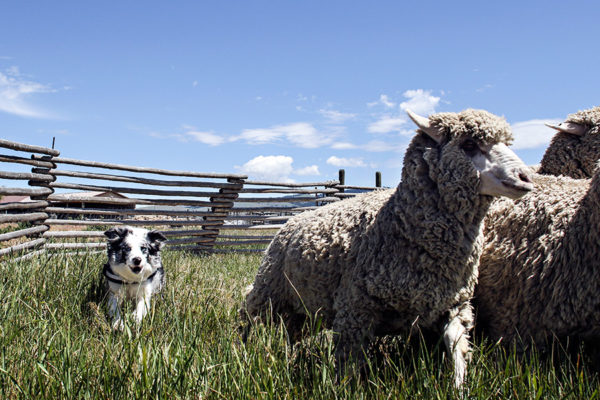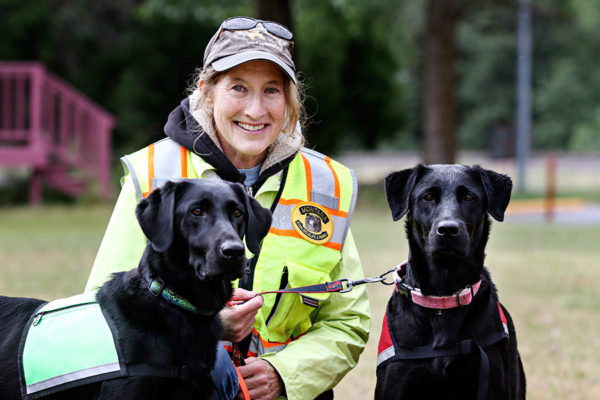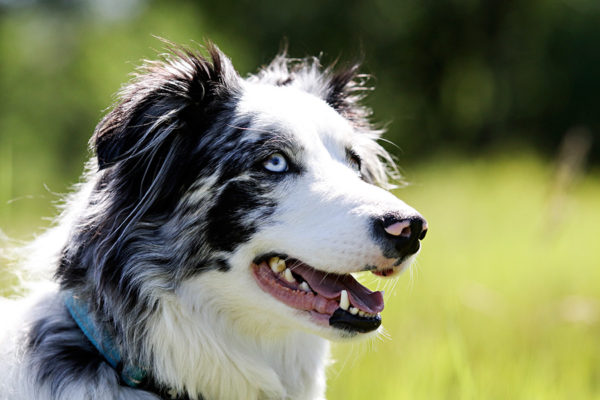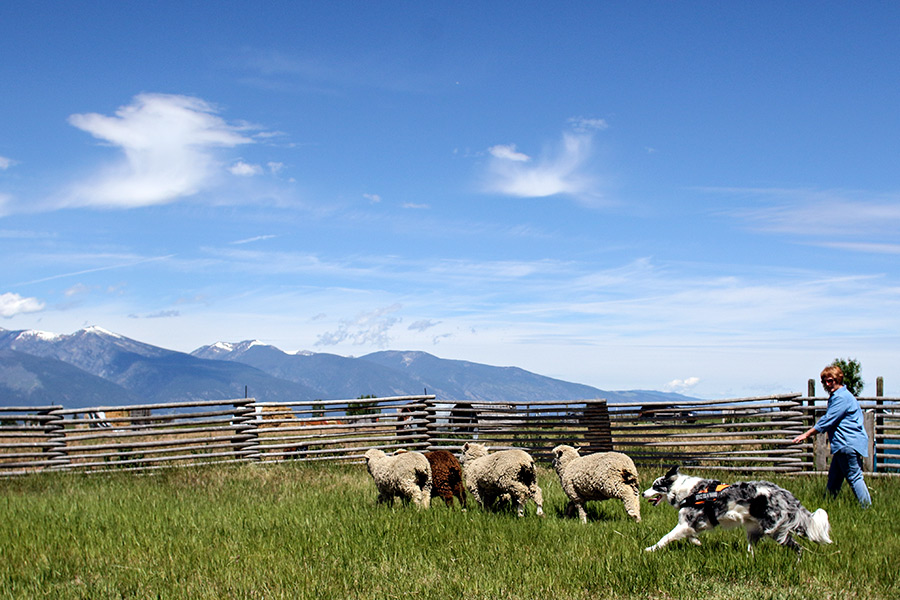STEVENSVILLE – When she first got here, the black-and-white longhaired border collie loved the wide open space of this ranch, but didn’t really understand the sheep.
Eight weeks ago, these unshorn yearlings smelled interesting and didn’t bark at her, but that was about as much as Gracie cared; she was in a new place, away from her family and her pet cat, and she needed to settle into her surroundings.
But last Friday, on a perfect, early-summer day down in the Bitterroot Valley of Western Montana, only the sheep existed. Gracie pulled politely at her leash, earning a couple “Excuse yous” from Wind River Bear Institute trainer Ally Cowan until it was finally her turn, her time to tap into the deep, instinctual urge to move those sheep from Point A to Point B.
A quick, flashy run at the bleating herd scatters them, but under shepherd Marie Everett’s direction, Gracie was soon loping in circles, pressuring the sheep to move forward in the corral.
Nearby, Gracie’s human, Mark Biel, rested his arms on the worn wood of the corral fence and watched with a smile. He’s tall and calm, with the quietness so often found in people who spend much of their time in the wilderness.
As the natural resources program manager in Glacier National Park, Biel was in as much training as Gracie last week. Together, they will be the first of their kind in the park – a human-canine duo whose job several days a week will be hazing away the bighorn sheep and mountain goats that tend to congregate on Logan Pass.
It’s a big jump from pet to environmental guard dog, but Gracie, like several other dogs who have recently taken jobs in conservation, is undaunted. During a break from chasing sheep in the heat, she trotted to Biel’s feet and rested in the shade, poking her soft muzzle through the fence for a scratch, which she quickly received, along with praise.
It’s this connection, the nearly automatic reaction from humans to the dogs, that’s important for Gracie and her brethren to be successful. Because really, though the dogs are the ones currently working, it’s human minds and behavior that need the training.
“Instead of just going up there and trying to chase the wildlife off, you’re really not going to change what you’re looking for. It’s people we’re trying to change,” Biel said. “But when you have a dog, especially a photogenic dog, people, you get them hooked.”

Humans and dogs have been working on the same team and benefiting from it for more than 33,000 years, according to an analysis of DNA research from the Royal Institute of Technology in Sweden.
In Montana, the romantic image of cowboys in the wide-open prairies herding cattle into the endless horizon isn’t complete without a faithful working dog there to help keep the livestock in line. Dogs also played the companion role when riding the trail meant seeing more animals than people.
Canines’ roles have evolved along with our needs. It is now common to see a K9 police unit with a German Shepherd in tow, ready to intimidate, track, and capture a fleeing suspect. Drug task forces, along with security forces in most transportation hubs, have utilized dogs’ incredible sense of smell to detect all manner of illegal substances. And medical alert dogs are specially trained to pick up on cues to help keep their people safe and alive.
Now, conservation groups hope to use those same attributes to accomplish their own goals through pilot programs using dogs as coworkers.
Gracie’s training at the Wind River Institute in Florence is a first. Wind River is well known for training Karelian Bear Dogs, which have been used in Glacier Park to haze grizzly bears away from areas with heavy human activity, like roadsides.
“Having worked in Glacier and having success there is part of the reason they were open to this [project],” Cowan said.
But training Gracie to herd prey, not predators, is a first for the institute.
“She’s the first dog of her kind for bighorn sheep and goats,” Cowan said.
To help, Cowan called on Marie Everett, who raises sheep near the institute with the help of a pair of keen, clever border collies named Cricket and Mack. Together, the team developed a strategy: Gracie would learn from Marie and Mack two to three days a week, while spending the rest of the time training to be a personable dog.
That meant remaining calm when random people walked into the office – Wind River also boards dogs, whose owners visit the office – and building her confidence.
Rewarding Gracie for a job well done is the easy part. She responds to treats and loves to chase a ball, and she soaks up a nice verbal affirmation to go along with scratches and pets.
Training here means learning to be partners with the dog, so the human, or Biel in this case, must learn to play his role as well.
“We ask a lot of these guys, especially our working dogs, but we give a lot too,” Cowan said.
Biel spearheaded the Gracie project after realizing the congestion at Logan Pass filled him with anxiety. Tourists and wildlife don’t mix, and a recent mountain goat study conducted at Logan Pass showed that the goats are becoming habituated to people.
They’re spending more time further from the cliffs and in human company, Biel said, because humans provide a couple of benefits. First, large groups of people tend to ward off predators. Second, humans emit a lot of salt, through urine and sweat, which attracts the goats.
Having a dog there could convince them it’s not as safe as they thought, though Gracie’s job will be driving them off and stopping, not chasing them. This puts pressure on the wildlife without overly stressing them, Biel said.
Waterton Lakes National Park, just across the border from Glacier in Canada, has used border collies to haze habituated deer in Waterton since 2010. Their efforts have been so successful that Biel figured he might be able to train his family dog to do the same.
He tried for a year and a half to get funding from the park to train Gracie, eventually receiving the $6,000 from the Glacier National Park Conservancy.
Along with mitigating potentially dangerous human-wildlife interaction, Gracie also has the role of ambassador. Biel said people respond differently to a park ranger telling them to stay away from wildlife than when they see a dog.
Opening a dialogue and explaining what Gracie’s job is will hopefully plant a seed in people’s heads about the importance of keeping wild animals wild and conserving the park.
“It helps that Gracie is as gorgeous as she is; she’s going to be a real eye-catcher,” Cowan said. “People love to be helpers of dogs.”

A little more than 50 miles north of the Wind River Institute on U.S. Highway 93, another pair of dogs were also hard at work in a conservation pilot program. But instead of keeping people away from wildlife, black Labs Rosebud and Ismay were working through a rainstorm to keep aquatic invasive species (AIS) away from Northwest Montana’s waterways.
The dogs, along with handler Deb Tirmenstein, were in their first week of work in Ravalli as the newest employees at the AIS checkpoints set up in strategic places around the state. Any driver with a watercraft must stop to be checked for AIS, specifically quagga and zebra mussels.
Late June rain proved no match for Ismay’s skills when a family from Arkansas pulled up with their catamaran. Though she’d never seen a boat like that, Ismay circled it with Tirmenstein, sniffing for mussels in holes too small for human eyes to investigate.
All three occupants in the truck got out at the mention of a dog.
“Get a picture of us getting inspected,” the woman from inside the truck told her son.
“What’s she looking for?” the young man asked Tirmenstein after snapping the photo, who then brought out a map to show the mussels’ progression from the Great Lakes, down the Mississippi, and into other states, including Arkansas.
It lasted perhaps 10 minutes, but the entire interaction was a perfect example of success for the pilot program. Tirmenstein is an employee with the Flathead Basin Commission, which works in tandem with the state Fish, Wildlife and Parks Department at the AIS checkpoints.
The goal of the canine pilot program is similar to that of Gracie’s: efficient and effective searching paired with education. Flathead Basin Commission executive director Caryn Miske said the idea of using dogs to seek out these tiny, destructive mussels came about in 2014, when the FBC paired with counterparts in Alberta to test dogs’ ability to pinpoint the mussels.
While the dogs can’t be expected to be perfect, they performed better than humans searching on their own. In tests in a boatyard, the dogs found the mussels 100 percent of the time, while the humans did not.
“They are not a magic bullet, they are not a panacea,” Miske said. “Part of it is dogs can do what we can’t do; their noses are amazing.”
Working together, the humans and the dogs should be able to detect most, if not all, of the contaminated boats.
“We can’t just say we’re going to send dogs out and we don’t need the human inspectors anymore,” Miske said. “There are places where a dog just simply can’t get their nose.”
There’s also that education component, along with the fact that most people are more interested in engaging with a goofy pup than another human.
“That is really, really valuable. People go to the inspection stations, they get there, they want to get on the water, they want to get out of there, and having a dog there to engage with kind of changes the whole dynamic,” Miske said. “It’s more fun, it’s more interesting and people smile when they see the dogs.”
There are three dogs involved in the program – Tirmenstein’s team of Rosebud and Ismay, who are sisters from the same litter and as puppies were initially trained to find human cadavers, along with yellow Lab Tobias and handler Ky Zimmerman posted at the Browning check station.
The three dogs and their handlers spent three weeks with California Fish and Wildlife K-9 training, and FBC also worked with Working Dogs for Conservation, a Montana-based nonprofit seeking to train invasive species-detection dogs building on the same techniques used for narcotics or cadaver detection.
In total, it cost about $45,000 to train the dogs and handlers.

The dogs wear cloth shoes on their front paws to keep them and the boats safe, and they are only trained to find mussels. Large signs spell out that these canines are not looking for drugs, guns, or alcohol. There were concerns that people might resist the dogs out of privacy concerns, but those have been thus far unfounded.
“We make it very clear that the dogs are not looking for contraband,” Miske said. “These dogs that we have have not even been trained to look for drugs or firearms.”
Pete Coppolillo, biologist and executive director at Working Dogs for Conservation, said the dogs are a vital evolution in AIS detection because sometimes the mussels aren’t present on the boats, but their microscopic larvae might be. These dogs can sniff out even those tiny strands of DNA, he said.
Initially, this kind of detection was used to track down elusive carnivore species in California. Conservation groups eventually realized that if the dogs can sniff out predators, they could sniff out other types of creatures.
“That’s what grew into the invasive species work, which is important,” Coppolillo said. “Prevention is huge, but if you do have an infestation of a species, if you catch it early, you’ve got a much better chance.”
Other dogs trained at Working Dogs for Conservation have patrolled Cherry Creek on Ted Turner’s ranch west of Bozeman, nearly 20 years after the first, controversial efforts to restore cutthroat trout.
These canines are attuned to the scent of invasive brook trout.
“Mostly we’ve been working on invasive fish,” Coppolillo said. “They can identify the fish to the species in the water.”
The dogs and their handlers have been working with federal agencies to build on existing identification practices. For example, researchers testing a stream for invasive species could use a sponge-like instrument that sits in the water and binds to organic molecules, including DNA.
That means researchers could tell if an invasive species swam through that water, Coppolillo said, but couldn’t tell where the fish came from.
“If you put them together, you can say there’s a northern pike or a brook trout in this watershed, and our hope is that the dog can lead you to it,” Coppolillo said.
Back in Ravalli, Tirmenstein’s team declared two boats clean, but the dogs are motivated by their desire for their favorite ball, so their handler needs to reward them. She planted a mussel on a piece of machinery, and in less than a minute, Ismay signaled by sitting, barking, and pressing her nose to the exact spot Tirmenstein placed the mussel.
“It takes a dog with a lot of drive to be successful,” Tirmenstein, who has worked with search and rescue dogs for years, said.
But sometimes the work pays for itself. During her first week of work, Rosebud searched a boat and hit the jackpot: a giant onion ring, which was promptly gulped down.
“I couldn’t stop her,” Tirmenstein said, laughing.

At the Wind River Institute last week, Gracie and Biel only had a couple of weeks of training left before they head back to Glacier, where they are expected to start work on Logan Pass in mid-July.
Biel had missed Gracie since her departure for Wind River on May 1, and was excited to be with his canine friend again. She would need to relearn her new commands in his voice, Cowan said, and her ability to push a herd instead of retrieving it still needed some work.
Soon, life for Glacier Park’s first-ever Bark Ranger will be all about interacting with thousands of new faces, posing for pictures, and huge, new critters that need to be moved.
But for the moment, in the heat of early summer in the Bitterroot, she’s panting in the shade, concerned only with the words coming out of Biel’s mouth.
“Good dog, Gracie,” he said.
